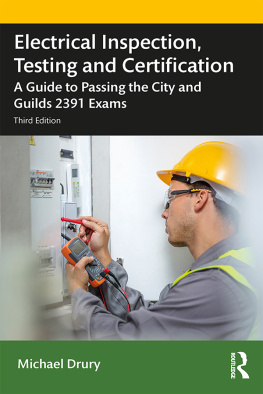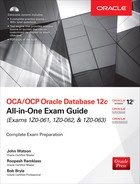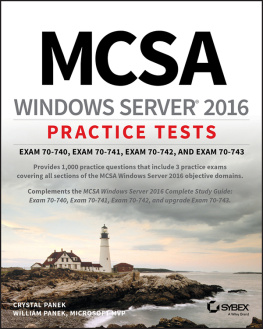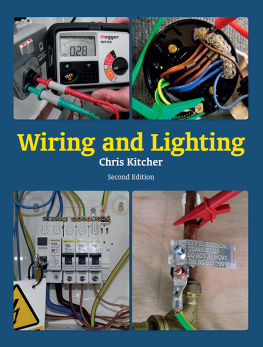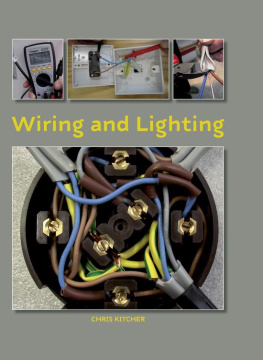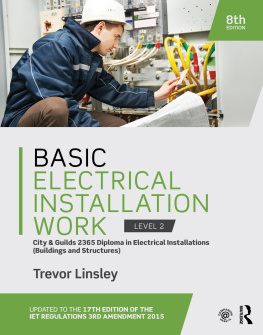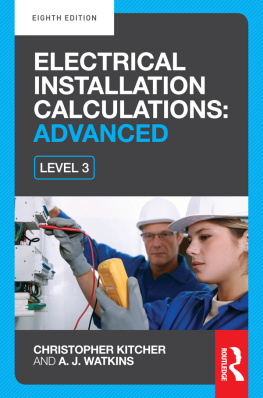Electrical Inspection, Testing and Certification
Updated in line with the 18th edition of the wiring regulations.
This book is an essential guide to the City & Guilds 2391-50 and 51: Initial Verification and Certification of Electrical Installation and Periodic Inspection and Testing, also C&G 2391-52: an amalgamation of Initial Verification and Periodic Inspection and Testing of electrical installations.
There is a full coverage of technical and legal terminology used in the theory exams; including the structure of exam questions and their interpretation. By running through examples of realistic exam questions in a step-by-step fashion, this book explains how to decode the questions to achieve the most suitable response from the multiple-choice answers given.
This book is ideal for all electricians, regardless of their experience, who need a testing qualification in order to take the next step in their career.
Michael Drury has worked in the electrical industry for over 50 years, and is currently working as a freelance electrical installation lecturer and as an on-site constructor, designer and inspector. Michael has worked in FE for 25 years and has also been employed as a contractor in the United Arab Emirates and Saudi Arabia.
Third edition published 2020
by Routledge
2 Park Square, Milton Park, Abingdon, Oxon, OX14 4RN
and by Routledge
52 Vanderbilt Avenue, New York, NY 10017
Routledge is an imprint of the Taylor & Francis Group, an informa business
2020 Michael Drury
The right of Michael Drury to be identified as author of this work has been asserted by him in accordance with sections 77 and 78 of the Copyright, Designs and Patents Act 1988.
All rights reserved. No part of this book may be reprinted or reproduced or utilised in any form or by any electronic, mechanical, or other means, now known or hereafter invented, including photocopying and recording, or in any information storage or retrieval system, without permission in writing from the publishers.
Trademark notice: Product or corporate names may be trademarks or registered trademarks, and are used only for identification and explanation without intent to infringe.
First edition published by Routledge 2016
Second edition published by Routledge 2018
British Library Cataloguing-in-Publication Data
A catalogue record for this book is available from the British Library
Library of Congress Cataloging-in-Publication Data
A catalog record has been requested for this book
ISBN: 978-0-367-43027-6 (hbk)
ISBN: 978-0-367-43026-9 (pbk)
ISBN: 978-1-003-00077-8 (ebk)
The process of inspecting and testing electrical installations has evolved over a number of decades, as electrical equipment has become more prolific and sophisticated. Consequently, the demands on the practising electricians are ever increasing both at the skills level and those imposed by accumulative regulative liabilities.
In order to cope with these increasing demands there is a constant urgency to develop and maintain appropriate and necessary skills to meet the pressures imposed on them by Statutory and Non-Statutory Regulations; which have sensibly been introduced and frequently up-dated, in order to reduce or possibly eliminate the number of fatalities, serious injuries in the work place and the domestic environment, also to prevent damage to property.
Safety has always been, and must be, at the forefront of all practising electricians work ethos, which oddly can be a problem when they sit the City & Guilds 2391 theory exams; simply because they have a natural reaction to solve or rectify an electrical fault, which may have been exposed during an inspecting and testing routine. Consequently, if a candidate (inspector/electrician) is presented with a question on a possible fault, defect or omission, this natural reaction may kick in. Unfortunately this type of response is not expected from the candidate during the theory exam.
The answer given will ultimately depend on the mode of the inspection paper, whether its Initial Verification, Periodic Inspection, or a combination of both, the response will be entirely different.
Accordingly candidates must always bear in mind their position as an inspector when sitting the theory exam(s); where they are expected to carry out the inspection and testing of an installation regardless of the type of inspection and give an account on its condition. Subsequently, it is paramount for the candidate (inspector) to understand the testing and inspection procedures, with all the associated certification and schedules, as laid down in the current version of BS 7671 Wiring Regulations and the IET Guidance Note 3 Inspection & Testing.
The inspector must also be fully aware of the safety procedures coupled with inspection and testing, moreover the action to be taken if, in the inspectors professional opinion, an installation is unsafe or does not conform to the designers criteria or BS 7671.
Consequently the objective of this book is to assist and review the working practices of the skilled electricians to ensure they are familiar with the details of both the statutory and non-statutory regulations, to assist in the decoding of questions and scenarios posed by City & Guilds, thereby gaining a greater understanding of the inspecting and testing of an electrical installation with the ultimate objective of ensuring an electrical installation is safe to use.
In order to achieve this objective the installation must comply with the designers criteria; its construction should conform to all aspects of BS 7671 and it has been inspected and tested to ensure it is in a satisfactory condition where it can be used safely.
A SUMMARY OF THE CITY & GUILDS 2391
The City & Guilds 2391 consists of three stand-alone Units, they are:
C&G 2391-50 Initial Verification of Electrical Installations.
C&G 2391-51 Periodic Inspection and Testing of Electrical Installations.
C&G 2391-52 Initial and Periodic Inspection and Testing.
There are numerous similarities between each Unit; however candidates will be expected, depending on the Unit taken, to have a detailed understanding of the following:
The requirements for either an Initial Verification or a Periodic Inspection of electrical installations.
The safety management procedures for either an Initial Verification or a Periodic Inspection when undertaking inspections and testing of electrical installations.
The requirements for carrying out either an Initial Verification or a Periodic Inspection of an electrical installation.
The requirements for testing either an Initial Verification or a Periodic Inspection of an electrical installation.
INTRODUCTION
The legal aspects of Statutory and Non-Statutory Regulations are probably the least consulted and possibly the most neglected components within the Inspection and Testing domain; whereas they should be regarded as the bedrock of the Inspection and Testing process.
When an inspector, generally the installation electrician on relatively small installations or as a signatory for larger installations, issues an Electrical Installation Certificate (EIC), it is a legally binding document, whereas an Electrical Installation Condition Report (EICR)

